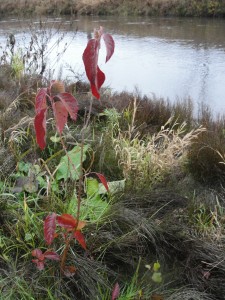Rachel Schattman with the Agroecology and Rural Livelihoods Group talks about the Vermont Agricultural Resilience in a Changing Climate Initiative, Rachel Schattman, a former UVM Center for Sustainable Agriculture and current doctoral candidate, conducted extensive interviews of Vermont farmers and agricultural service providers. Her goal was to delve into the approaches Vermont farmers are taking to increase resiliency and limit the risks they face due to changing climate. Rachel’s project also investigates the role of the service provider in improving agricultural resilience and the key adaptation strategies for Northeastern farmers.
The full publication can be found here.
Center for Sustainable Agriculture (CSA): We find your publication very helpful in terms of identifying and categorizing the dominant adaptation approaches of farmers in the state and region. Through your interviews, did you get the sense that farmers and service providers were on the same page regarding climate change? Was it as much of a priority for farmers as it was for service providers?
Rachel: For this part of the project, we interviewed 15 farmers and 12 service providers. Both groups were clear that climate change is real and that it is a big deal for everyone in agriculture, though not everyone has the same degree of knowledge about climate change or how it will affect agriculture in the northeastern United States.
People get their information about climate change from different sources, and there are differences in whether people are thinking five years into the future or 50 years into the future.
It’s less a case of farmers thinking one thing and technical service providers thinking another, than a situation where farmers are not all of one mind and nor are technical service providers.
Specifically, we asked farmers how much climate change played into their farm management decisions, and we asked technical service providers if and how they talked about climate change with farmers. The farmers did not all prioritize climate change to the same degree: those that suffered losses with Tropical Storm Irene, or who were located in areas where erosion and flooding are reoccurring challenges, tend to be more concerned. These farmers know that climate change in the Northeast will likely mean more frequent and intense rainstorms, more floods, etc. We found that these farmers had knowledge of climate change that was more accurate and nuanced than other farmers. Likewise, some technical service providers were highly knowledgeable about climate change and others were less so, though most had questions about how to best support the farming community through the changes that are to come.
CSA: Diversification, in a variety of ways, is a time-tested risk mitigation strategy and was a dominant adaptation strategy of the farmers you interviewed. Was it your impression that farmers diversified initially to mitigate risk from other sources, and then continued after seeing the benefits for climate change resilience? Or was it the impacts of climate change that prompted the diversification?
Rachel: Yes, diversification is a widely used strategy for mitigating many different types of risk including economic, ecological and production risks.
These risks are not unique to climate change, but are intensified by the pressures that climate change puts on farms.
Increased intensification of risk can look like a field that has flooded every 25 years in the past starting to flood more frequently under new climatic conditions. It can also look like spikes in fungal diseases on plants because of more humidity and warmer atmospheric temperatures.
All of the potential ecological changes affect farmers’ financial stability and success.
A farmer’s initial reason for diversifying may have been market related (e.g. wanting to have several different types of sales avenues), crop or product related (e.g. drought or moisture resistant crops, animal and crop systems), or a livelihood decision (e.g. off-farm jobs or other sources of income). The type of diversification a farmer chooses depends on the specific threats their business faces and the particular resources they have to draw upon.
The farmers that we interviewed reported diversification strategies that were originally adopted for reasons other than climate change. They also acknowledged that these same strategies put them in a good position as climate change intensifies preexisting threats such as increased frequency and intensity of storms and flooding.
As farmers learn more about climate change, they also tweak their diversification strategies. For example, we interviewed one business owner who chose to site several new greenhouses on a piece of land that is less vulnerable to high winds, which she believes will be a more important factor in the future. This same farmer chose stronger construction materials for the greenhouses because she believes structural integrity of these structures would become more of an issue as intense storms become more frequent.
Diversification strategies originally adopted for reasons other than climate change put farmers in a good position as climate change intensifies.
Diversification Strategies |
Water Management Strategies |
Innovative Production Strategies |
| Markets | Irrigation | Plastic mulch |
| Products | Organic matter management | Hoop houses |
| Household income | Erosion control | Robotic milking |
| Land-base | New crops |
Schattman, R.E., H.M. Aitken, V.E. Méndez & M. Caswell (2014) Climate change resilience on Vermont farms: a research report for service providers. ARLG Research Brief # 2. Agroecology and Rural Livelihoods Group (ARLG), University of Vermont: Burlington, VT.


